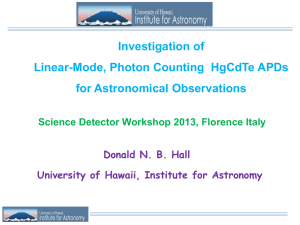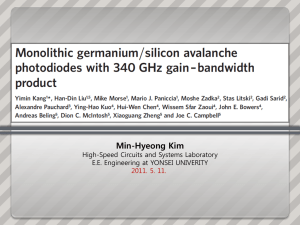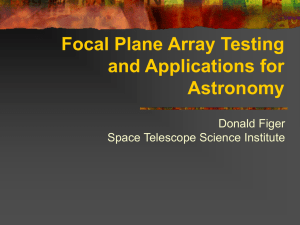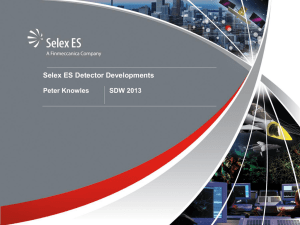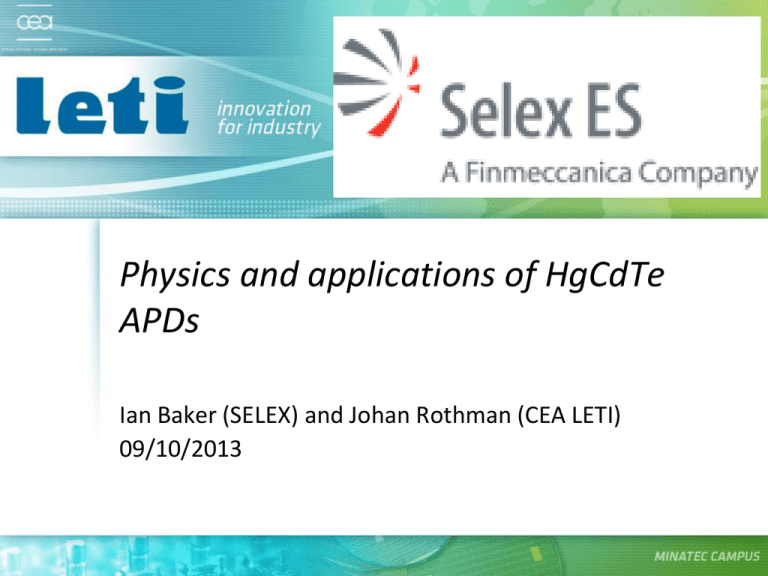
Physics and applications of HgCdTe
APDs
Ian Baker (SELEX) and Johan Rothman (CEA LETI)
09/10/2013
Outline
Amplified photodetection
HgCdTe APDs physics and limitations
HgCdTe APD
HgCdTe APD applications with arrays (imagery) and
single pixel detectors
Summary/perspectives
Physics and applications of HgCdTe APDs,
Baker and Rothman 9.10/2013
|2
© CEA. All rights reserved
Amplified photodetection
Physics and applications of HgCdTe APDs,
Baker and Rothman 9.10/2013
|3
© CEA. All rights reserved
Photodetection without internal gain
Photon signal
Readout noise sRO
Measured signal
Physics and applications of HgCdTe APDs,
Baker and Rothman 9.10/2013
|4
© CEA. All rights reserved
Photodetection with gain M
M x Photon signal
Internal
photodetector gain
M
RO noise
M
Measured
signal
The gain extracts the signal from the read-out nosie:
Low signals and/or high read-out noise :
0.001- 10 000 photons per observation time
Physics and applications of HgCdTe APDs,
Baker and Rothman 9.10/2013
|5
© CEA. All rights reserved
Photodetector gain
PD
gain
Amplifies the signal to avoid SNR degradation due to
the noise in the read-out electronics
Avoid loosing information … at best:
P(M)
M
<M>
SNRout
Excess noise
factor
M
SNRinQE
SNRinQEFR
F
SNRin
M
F
1
SNRout
M
2
2
Information conservation FM
QEFR
QE
F
Physics and applications of HgCdTe APDs,
Baker and Rothman 9.10/2013
|6
© CEA. All rights reserved
MxSignal+ Read out noise (Noise floor)
M
Avalanche gain with low excess noise
100mV
Signal x QE
Signal (100 photons)
10mV
Amplified SNR
Variance in gain
multiplies photon
noise x√F
1mV
Output voltage
100µV
~Photon
SNR
Photon noise
(10 x√QE)
(F=APD excess
Noise Factor)
Electronic noise floor (FN)
10µV
Dark current noise
1µV
Increasing Gain
The object of avalanche gain is to increase the signal and
photon noise above the fixed noise of the system
QEFR=QE/F should be maximal
Dark current noise should be minimal
Physics and applications of HgCdTe APDs,
Baker and Rothman 9.10/2013
|7
© CEA. All rights reserved
HgCdTe avalanche photodiodes
- Typical gain curve
- Gain Probability Distribution Function (PDF) and
excess noise factor
- Gain physics (geometry, lc, temperature)
- Dark current limitations
- Response time measurements
Physics and applications of HgCdTe APDs,
Baker and Rothman 9.10/2013
|8
© CEA. All rights reserved
HgCdTe Avalanche photodiodes (APDs)
Gain
gain M
Multiplication
10000.0
Signature of multiplication without avalanche
breakdown:
Single carrier multiplication: SCM !!!
1000.0
100.0
10.0
1.0
-14.0 -13.0 -12.0 -11.0 -10.0
-9.0
-8.0
-7.0
-6.0
-5.0
-4.0
-3.0
-2.0
-1.0
0.0
Bias (V)
Reverse bias (V)
Avalanche gain M>1000 to detect light from uv to the IR cut-off
wavelength
Low excess noise factor F=1.1-1.3 (DRS, Selex, BAE, Raytheon, CEA)
Information conservation record : QEFR ~60-90 %
QEFR < 0.5 for all other amplified detectors (PM, Si/II-V APDs, EMCCD..) !
Potentially the best detector for low photon detection and photon
counting ?
Physics and applications of HgCdTe APDs,
Baker and Rothman 9.10/2013
|9
© CEA. All rights reserved
Multiplication gain distribution estimated
from single photon detection (CEA-LETI)
APD
APD hybridised on a
low noise ROIC
Noise/TC = 10-20 elect.
BW= 7 MHz
APD
Cold filter
Residual thermal flux detected with MWIR APD 4.6 µm)
Single photon events 1.6MHz (Ires=230 fA)
ADV=0 (flux zéro)
Dark events
amp (V)
DCR=20-300 kHz
Seuil de <M> à 0.25 <M>
(DCR SWIR << 10 kHz)
time (µs)
Physics and applications of HgCdTe APDs,
Baker and Rothman 9.10/2013
| 10
© CEA. All rights reserved
Gain probability density function (PDF) of
MWIR CEA-LETI HgCdTe APD at 80 K
<M>=368
F 1
M2
M
2
=1.25
Direct estimation of F= 1.25
The observed distribution enables high photon detection
efficiency and the possibility to make photon number resolved
(PNR) detection
PDE=90 % at 0.5x<M>
At the limit of PNR which is not possible with F>1.3 (F>=2 EMCCDs, SI/III-V APDs)
Physics and applications of HgCdTe APDs,
Baker and Rothman 9.10/2013
| 11
© CEA. All rights reserved
Linear mode photon counting with a CEALETI HgCdTe APD
DC generation
p
Measured
Distributed dark-current generation
i
n
Measured 1 photon
APD gain PDF (+dark counts > 6 mV)
DCR=20-300 kHz
Seuil de <M> à 0.25 <M>
Distributed dark current generation
Discrimination of non-amplified dark current events Lower
DCR
Low noise on the amplified dark current Noise on the dark current is
the limiting parameter
Physics and applications of HgCdTe APDs,
Baker and Rothman 9.10/2013
| 12
© CEA. All rights reserved
Avalanche gain in HgCdTe –
illustration of single carrier (electron) history dependent impact ionisation
Foundations for MCT APD technology
Absorption of photons must be on the P-side to generate
electrons for full benefit of avalanche gain.
hv
Above a depletion width of 2.5-3.0µm1,2 alloy and phonon
scattering starts to impact ionisation threshold voltage.
Below approximately 1.0 to 1.5µm there is risk of gain saturation
and tunnelling currents.
1.5-2.5µm is technologically convenient
Electron and hole
velocities limits the
response time
Potential energy
Low F due to
spatially ordered
multiplication
Heavy hole mass – 0.55m0 - low mobility
Holes must migrate to P-region to complete signal
but otherwise do not take part in avalanche process
hence low noise figure in HgCdTe
Recent literature
1
Johan Rothman, Laurent Mollard, Sylain Gout et al, “History-Dependent Impact
Ionisation Theory Applied to HgCdTe e-APDs”, Jn of Elec Mat, Vol 40, No 8, 2011
2
Mike Kinch and Ian Baker, “HgCdTe Electron Avalanche Photodiodes”, Chapter
21, Mercury Cadmium Telluride - Growth, Properties and Applications, published
by Wiley
Physics and applications of HgCdTe APDs,
Baker and Rothman 9.10/2013
| 13
© CEA. All rights reserved
Influence of junction geometry on gain and noise
Front side illuminated APDs with lc=4.6 µm at T=80 K
Planar N+n-P diodes in
EPL and MBE grown epitaxies
N+
<wC> n-~1014 cm-3
P~
1016
Gain in CEA- APDs with different <wc>
Tunnel currents
wc=1.4 µm
wc=0.8 µm
cm-3
wc=2.4 µm
The gain is correlated with the average junction extension
Increased threshold voltage, ~ constant slope
Gain variation have been modeled as a function of xCd and T*
The excess noise has been found increases with increasing
junction width
Junction geometry fluctuations and enhanced uncertainty on the gain ?
*Rothman
et al, JEM 41, 2928 (2012)
Physics and applications of HgCdTe APDs,
Baker and Rothman 9.10/2013
| 14
© CEA. All rights reserved
Gain as a function of lc at T=80 K
CEA-Leti APDs
5.3 µm
3.9 µm
3.3 µm
3.0 µm
3.0 µm
2.5 µm
The gain decreases with decreasing lc
Exclusive electron multiplication with low F have been demonstrated down
to lc= 2.2 µm (M=20 at 20 V)
Limits the lowest possible dark current
The behavior of lower lc APDs is still not clear
Onset of hole multiplication will strongly increase F and kill the
particularity of HgCdTe APDs !
Physics and applications of HgCdTe APDs,
Baker and Rothman 9.10/2013
| 15
© CEA. All rights reserved
Variation of the gain as a function of
temperature (lc=3.3 µm at T= 80K)
200K
220K
180K
273 K
293 K
The gain decreases as a function of temperature
Local gain model variation of the band gap and increased
(low) energy dispersion *
*Rothman
et al, JEM 41, 2928 (2012)
Physics and applications of HgCdTe APDs,
Baker and Rothman 9.10/2013
| 16
© CEA. All rights reserved
Dark currents in HgCdTe APDs
Ieq_in @ 80 K
1000
Ieq_in (Mdark< M)
100
i
I eq _ in
n
2
idark
_ out
2
2qM F
Ieq_in - Icc (fA)
p
Ieq_in (pA)
DC generation
10
1
0.1
I rp
0.01
0.001
2.5
3.0
3.5
4.0
4.5
5.0
5.5
Cut-off wavelength (µm)
Ieq_in decreases lc at constant gain and
temperature
Dark current of 10 e/s have been observed for
APDs with lc>3.0 µm Low flux applications
in astronomy
Wavefront sensing, interferometry…
1G.
2J.
Perrais (Ph.D.S.), et al., J. electron. Mater., 36, 963 (2007)
Rothman, et al., Proc. SPIE, 7834, 78340O 2010
Physics and applications of HgCdTe APDs,
Baker and Rothman 9.10/2013
| 17
© CEA. All rights reserved
3 µm cut off FPA : dark measurement
CEA-LETI/SFD FPA (RAPID)
Under ~ 100 K, both currents reaches the same low level limited by the glow
At VAPD = -6,3 V, the GR dominates gain normalized current under 190 K
Would reach sub 5x10-15 A/cm² or 0.3 e-/s/pixel @ 80 K without glow
1.E-02
1.E-03
At low bias, diffusion
limited at temp. > 140 K
Jgr
1.E-04
Jdiff
1.E-05
FPA @ 3µm Jdark(6,3V) / M
Jdark (A/cm²)
1.E-06
1.E-07
FPA @ 3µm Jdark (-0,2V)
1.E-08
1.E-09
1.E-10
1.E-11
ROIC Glow ~ 50 e-/s/pixel
1.E-12
1.E-13
1.E-14
1.E-15
50
100
150
200
250
T(K)
Physics and applications of HgCdTe APDs,
Baker and Rothman 9.10/2013
| 18
18
© CEA. All rights reserved
Response time variation as a function of
bias and gain
Localized injection (APD center)
T= 80 K
-- M= 1.( (6 V), risetime 50 ps
-- M=5 (10 V)
-- M= 35 (14 V)
-- M= 70 (16 V)
-- M= 130 (18 V), risetime 100 ps
Delayed response at high gain with constant exponential
decay with t =270 ps
Exponential decay due to impedance miss-matching
Delayed response is due to a reduction of electron and holes velocities
ve=3.5x106 cm/s, vh=1.5x106 cm/s
BW 10 GHz in narrow junctions (optimized resolution~20 ps)
Close to Independent on temperature Physics and applications of HgCdTe APDs,
Baker and Rothman 9.10/2013
| 19
19
© CEA. All rights reserved
High gain perspectives Impulse response with substrate
xj=3.4 µm APD at T=180 K
Stable gain M=1800 at 28 V
(edge and center response)
At 28 V and M= 1800 (180 K)
Gain in excess of 1000 enables photon-counting with
sub ns resolution using deported transimpedance
amplifier (TIA)
But at reduced BW is expected due to the large xj ~ 2 GHz
Physics and applications of HgCdTe APDs,
Baker and Rothman 9.10/2013
| 20
20
© CEA. All rights reserved
Electronic engineers view of an avalanche photodiode in HgCdTe
The very impossible amplifier
• Voltage controlled gain at the point of absorption
• Little additional noise
• Up to (10) GHz bandwidth
• Requires no Si/Ge/III-V real estate
• Negligible power consumption
• Negligible non-uniformity
• Shrinkable to the micron scale
• Fundamentally highly stable
Ian Baker : Quite a useful component!
Physics and applications of HgCdTe APDs,
Baker and Rothman 9.10/2013
| 21
© CEA. All rights reserved
HgCdTe APD technologies
SELEX, DRS, Raytheon, BAE, LETI
Physics and applications of HgCdTe APDs,
Baker and Rothman 9.10/2013
| 22
© CEA. All rights reserved
Avalanche photodiode technologies:
Selex (UK)
Selex (UK) and DRS (US)
P absorber
hv
hv
Graded composition
P+ to p-
Avalanche region nN+
N+
Avalanche region n-
LPE/via-hole technology
Excellent breakdown quality
High avalanche gain
Panchromatic spectral response
MOVPE/mesa technology
Higher operating temperature
High avalanche QE
Few pixel defects
Low excess noise F
Wafer scale processing
Physics and applications of HgCdTe APDs,
Baker and Rothman 9.10/2013
| 23
© CEA. All rights reserved
Avalanche photodiode technologies :
CEA-Leti/Sofradir (Fr) and BAE (US)
hv
Raytheon (US) ? (cf. Don Hall)
hv
Absorbing layer
Avalanche region
Collection layer
Planar LPE technology
Excellent breakdown quality
High avalanche gain
MBE/mesa technology
Panchromatic spectral response
Higher operating temperature
Fast response
High avalanche QE
Low gain dispersion
Fast response
Low dark current
Low F
High operability
Physics and applications of HgCdTe APDs,
Baker and Rothman 9.10/2013
| 24
© CEA. All rights reserved
HgCdTe APD applications
- MWIR HgCdTe APDs for imagery
- SWIR HgCdTe APDs for imagery
- Singel element applications
Physics and applications of HgCdTe APDs,
Baker and Rothman 9.10/2013
| 25
© CEA. All rights reserved
Typical performance of MWIR HgCdTe
Linear APD gain record
APDs at 80 K
M=12 000 (SFD 2011)
Parameter
Quantum efficiency
Max gain
Bias at M =100
Excess noise factor F
I eq_in at M=100
Typical response time T90-10
Maximum GainxBW product
Value
60-80 %
000
1312000
7-10 V
1.1-1.4
10 fA
2-10 ns
2.1 THz
References
[13]
[13], [14]
[8],[15]
[8],[15], [17]
[8],[13]
[9], [10]
[10]
Multifunctional thermal and/or active imaging
Detection and identification
Aerospatiale navigation
Bio-medical research/cancer detection
FPAs for short integration times (30 ns – 1 µs) have been
developed by Selex, DRS, CEA/SFD and Raytheon
Physics and applications of HgCdTe APDs,
Baker and Rothman 9.10/2013
| 26
© CEA. All rights reserved
SWIR HgCdTe APDs
100
80K performance
Parameter
Quantum efficiency
Max gain
Bias at M =100
Excess noise factor F
I eq_in at M=24
Typical response time T90-10
Value
60-80 %
600 at 20V
12-14 V
1.1-1.4
2(<aA
0.05aA) ?
0.4-10ns
ns
5-20
○
●
□
■
lc=3.9 µm
lc=3.3 µm
lc=3.0 µm
lc=3.0 µm
lc=2.5 µm
10
1
0.0
1.0
2.0
3.0
4.0 5.0 6.0
Bias (V)
7.0
8.0
Reduced gain at constant reverse bias
Reduced dark current at constant bias and temperature
Passive low flux fast frame rate imaging
9.0 10.0
FIT 80 K\3059\20h_0.xls
FIT 80 K\3061\20h_0.xls
FIT 80 K\3143\20h_0.xls
FIT 80 K\3144\20h_0.xls
FIT 80 K\3184\20h_4.xls
SELEX SAPHIRE Presentation by Gert Finger
RAPID CAMERA (LETI/SFD/IPAG/ONERA/LAM), Presentation by Philippe Feautrier
High operating temperature (200-300 K) for high BW
applications :
active imaging (2D, 3D)
single element detection …
Physics and applications of HgCdTe APDs,
Baker and Rothman 9.10/2013
| 27
© CEA. All rights reserved
Uniformity of avalanche gain in LPE/via hole technology at SELEX
Normalised laser signal as function of avalanche gain
60
58
Output signal (mV)
56
54
52
Gain - x14
50
Gain - x28
48
Gain - x38
46
44
42
40
350
360
370
380
390
400
Pixel number
Avalanche gain adds virtually nothing to non-uniformity
Depends only on voltage and alloy composition
Physics and applications of HgCdTe APDs,
Baker and Rothman 9.10/2013
| 28
© CEA. All rights reserved
Example of avalanche gain in astronomy using LPE/via hole technology
SELEX Saphira
APD sensor
Cutoff - 2.45 µm
Temperature - 40K
Int. time – 5.06ms
Bandwidth – 5MHz
APD gain – 33x
In photon starved applications can get two orders of magnitude
improvement in sensitivity compared with conventional sensors
Courtesy: Gert Finger - ESO
Physics and applications of HgCdTe APDs,
| 29
Baker and Rothman 9.10/2013
© CEA. All rights reserved
MOVPE technology for advanced eAPDs at SELEX
Mesa isolation provides photon
confinement for high absorption
efficiency and reduction of
crosstalk and stray light export
Wide bandgap N-type
Bandgap engineering to
minimize breakdown, dark
currents and response time
Narrow bandgap N-type
for avalanching
Junction
All photo-electrons experience
avalanche gain
Wide bandgap P-type
Physics and applications of HgCdTe APDs,
Baker and Rothman 9.10/2013
| 30
© CEA. All rights reserved
Ultra fast SWIR e-APD
FPA and Camera
Minalogic (Rhone-Alpes/Isère) funded project :
Partners:
FPA developement : CEA-Leti, Sofradir
Camera development and demonstration : IPAG, Onera, LAM…
Measured Detector performance
320 x 240 pixels 30 µm pitch APD array : LETI on top
8 outputs of 60 row @ 20 MHz : Sofradir bellow
Wavelength: 0.2 – 3.2 µm
M=10-30, QE/F~0.7
Full frame readout: 1500 Hz (0.67 ms) min, up to 2 kHz, pixel frequency 20 MHz
Windows: one rectangular window of any number of lines, each line read in 2.7 µs
Maximum “fram rate” = 370 kHz
26/09/2011
31
System Noise: ~ 2-3 photons at 1500 Hz frame rate (with gain x15)
Median Dark current : ~ 10 e/s/pixel
Full well: 40 000 e (with gain x1) low SNR images
Gain and dark noise operability : >99.5% at low flux
Physics and applications of HgCdTe APDs,
Baker and Rothman 9.10/2013
Ultra fast and sensitive
| 31
© CEA. All rights reserved
apd
meas
Filtre medianMoyen : 2.00xMed, 0.30xMoy
Op. 99.765 % : Pix OK [2.16e+01 4.01e+01]
Stat : 192 defs ; 36 defs inf ; 13 defs sup (143 defs in)
Moy = 3.086e+01 ; Med = 3.0798e+01 ; Std = 2.1906e+00
apd
Filtre absolu : 0.000e+00 2.000e+00
Op. 99.683 % : Pix OK [0.00e+00 2.00e+00]
Stat : 259 defs ; 0 defs inf ; 76 defs sup (183 defs in)
Moy = 9.876e-01 ; Med = 9.7533e-01 ; Std = 2.6344e-01
3.3 µm lc RAPID FPA : VAPD = -8 V
40
FPA photonic measurement @ TFPA = 80 K, VAPD = -8V
1.5
35
Excess noise
Gain
1
<Fmeas> = 0,99
Hyp. : quantum efficiency increase
0.5
with bias hM>h1
30
<M> = 31 ; Median = 30,8
99,8 % Operability (+/- 50%)
25
1
1
0.8
0.8
Relative nb of pixels
Relative nb of pixels
𝐹𝑚𝑒𝑎𝑠
0.6
0.4
0.2
0
2
25
30
Value
35
40
𝜂1
≞
𝐹
𝜂𝑀
0
0.6
0.4
0.2
0
0
0.5
1
1.5
2
Value
Physics and applications of HgCdTe APDs,
Baker and Rothman 9.10/2013
| 32
32
© CEA. All rights reserved
0.62
3,3 µm lc RAPID FPA: QEFR
0.6
QEFR is the only measurable FOM 𝑄𝐸𝐹𝑅 ≝
0.58
0.56
hM
𝐹
It can be estimated from measurable FOM
h
0.54
𝑄 ≞ <𝐹 1 >
𝑚𝑒𝑎𝑠
𝐸𝐹𝑅
0.52
<QEFR> = 0,57 for at a gain 31 !
Relative nb of pixels
1
0.8
0.6
0.4
0.2
0
0.52
0.54
0.56
0.58
0.6
0.62
Value
Physics and applications of HgCdTe APDs,
Baker and Rothman 9.10/2013
| 33
33
© CEA. All rights reserved
3,3 µm lc RAPID FPA : dark noise
FPA input referred dark noise @ M=31 : end user FOM
TFPA = 82 K, VAPD = -8 V, Tint = 600 µs
Pixel by pixel input referred dark noise evaluation
Mean noise = 1,7 e- ; Median 1,5 e99,54 % of pixels with noise < 10e-
Moy = 1.734e+00 e- ; Med = 1.5168e+00 e- ; Std = 7.7772e-01 e377 défs (0.00e+00 > Pix > 1.00e+01 ) ; Op 99.538 %
253 défauts en entrée ; 7 défauts inf et 117 défauts sup
FPA 1301 ; Ndark noise /M ( Vapd = -8 V ; Tint = 6.0e-04 s)
Valeurs filtrées ; Filtre de type : absolu
Defective pixel out of [0.000e+00 1.000e+01]
10
1
9
0.9
8
0.8
7
0.7
6
5
4
Relative nb of pixels
0.6
0.5
0.4
3
0.3
2
0.2
1
0.1
0
0
0
1
2
3
4
5
6
7
8
9
10
Value
Physics and applications of HgCdTe APDs,
Baker and Rothman 9.10/2013
| 34
34
© CEA. All rights reserved
Single element (mini-arrays )
System requirements and/or Optimisation is different than in
FPA applications:
BW/operating temperature/sensivity/active area…
Spectroscopy
-nanoscience/biochemistry
TC=1s-1ns
Signal=0.001-10000 photons
Direct detection
/Lidar/optical meas.
-Gaz analysis /TOF/
TC=50 ns- 10ps
Signal 0.001-100
photons/TC
Telecom
TC=10 ns-10ps
Signal 1-1000 photons
Photon counting (number resolved)
-Quantum physics/
/high-energy phys./astrophys./biomed.
TC=1s-10ps
Physics and applications of HgCdTe APDs,
Baker and Rothman 9.10/2013
| 35
© CEA. All rights reserved
Detection system adapted to system requirements
High operating temperature
Deported amplifier
APD
Cold finger
(TEC
cooled)
BW 1Hz à 60 GHz
Noise 300-1000 électrons/TC
Compatible low T TEC <180 K
LIDAR, Télécom, Bio-médicale,
science (magnéto-optique)
High sensitivity
Hybridized amplifier
BW max ~ GHz
noise 10-100 électrons/TC/pixel
APD
Low temperature
Cold finger
Intelligent MUX
Photon counting resolution
Optique quantique/
LIDAR/fluorescence
moléculaire/spectroscopie…
Physics and applications of HgCdTe APDs,
Baker and Rothman 9.10/2013
| 36
© CEA. All rights reserved
HgCdTE APD for LIDAR application with
deported TIA
Expected performance, iTIA= 1pA/Hz0.5 f=120 µm ,lc=3.15 µm à 180 K
APD
Limited by TIA noise (gain(T, xCd)
NEPh
)
Gain
Limited by dark current (Top, f, xCd)
System optimization/ Operating temperature (high/low) :
Signal ↔BW ↔ TIA noise ↔ Surface ↔ gain ↔ lc(xCd)
2 Demonstrators with deported TIA are currently being assembled at CEA
BWTIA=30 MHz, iTIA<1 pA/Hz0.5 , Top=160-200 K (TEC), f>100 µm : CO2, H20, CH4 LIDAR
BWTIA=480 MHz, iTIA=2.1 pA/Hz0.5 Top=180-220 K (TEC): TOF, free space telecom
Physics and applications of HgCdTe APDs,
Baker and Rothman 9.10/2013
| 37
© CEA. All rights reserved
Performance MEATS-1 detector(CEA)
BW TIA=450 MHz
BW APD=50 MHz (diffusion
limited)
NEP= 20 fW/Hz0.5
Active area 160 µm
Top=192 K
Impluse response of 30 µm diode at 1 nW input power (APD gain=50)
Physics and applications of HgCdTe APDs,
Baker and Rothman 9.10/2013
| 38
© CEA. All rights reserved
MEATS-1 for lunar laser
communication with ESA and NASA
RF MEATS detector is waiting for photons from the moon on
Tenerife
Physics and applications of HgCdTe APDs,
Baker and Rothman 9.10/2013
| 39
© CEA. All rights reserved
Photon counting detector perspectives
First CEA/Leti
photon counting
demonstration,
BW=7 MHz
APD
APD- with low noise ROIC and/or fast amplifier
Quantum physics and telecomunications, Lidar, spectroscopy,
fluorescence life time, real-time physics
Optimal detector performances (applications)
High PDE : ok > 90 %xQE
Low DCR : ~ok (< 1 kHz in SWIR) at low temperature
Photon number resolution : ok
Temporal resolution 20 ps-10 ns
Max repetition rate : 1- 10 GHz: possible, with external TIA and high
gain > 300
Spatial resolution -> photon counting imager : possible
Physics and applications of HgCdTe APDs,
Baker and Rothman 9.10/2013
| 40
© CEA. All rights reserved
Summary
HgCdTe APDs detects 0 to 1000 photons with minimal loss of
information from uv to IR
High gain M>1000
Record high QEFR~60-80 %
Idark (Ieq_in) down to electrons/s
HgCdTe APD FPAs for active and passive imaging have been
demonstrated with performances close to non-amplifed FPAs
Low noise, high uniformity, high operability > 99.5 %
Single/multi element detectors
Large horizon of applications
2 demonstrators are under developments
BW=30 et 500 MHz, NEPh< 10 photons (NEP< 10 fW/Hz0.5) à Top~200K
Demonstration of photon counting
Perspectives
Cameras and detectors with optimized QE, F, Ieq_in, BW, operating temperature
Photon counting arrays and detectors with photon number resolution
Single photon detection with sub-20 ps resolution at record high PDE
Physics and applications of HgCdTe APDs,
Baker and Rothman 9.10/2013
| 41
© CEA. All rights reserved
Merci de votre
attention
Avalanche gain in astronomy applications
100mV
Need a new figure of merit for APDs
as noise is now a combination of photon noise, gain noise
and system noise
10mV
Signal (100 photo-electron)
1mV
Output voltage
Photon noise
(10e rms)
100µV
Electronic noise floor (FN)
10µV
1µV
Increasing gain (bias voltage)
APD system sensitivity:
Noise Equivalent Photons
NEPh (SELEX def)
2 0.5
F
2.FN
NEPh
1 1
2.Q F .T .M
F – Noise Figure
Q – Quantum efficiency
FN – Fixed noise
T – Transfer function
M – Avalanche gain
Physics and applications of HgCdTe APDs,
Baker and Rothman 9.10/2013
| 43
© CEA. All rights reserved
Example of NEPh-Selex in a practical system
NEPh drops pro rata with avalanche gain until the photon noise becomes
significant.
It then limits to some value dependent on the stray light and dark current.
The ultimate sensitivity is noise figure/QE (1/QEFR)
160
Cutoff – 4.4µm
140
Fno - 4.5
120
Quantum efficiency – 0.7
Temperature – 90K
100
NEPh
Fixed noise - 50µV rms
0.5us
Noise Figure – 1.3
80
1us
2us
x3
60
40
x6
x12
x25
x50
5
6
7
Ultimate NEPh is
noise
figure/QE=1/QEFR
20
Actual NEPh
effected by stray
light and dark
current
0
0
1
2
3
4
8
APD bias voltage
Physics and applications of HgCdTe APDs,
Baker and Rothman 9.10/2013
| 44
© CEA. All rights reserved
Dark measurement on a RAPID retina
with 3 µm cut off
Evaluate the dark current (low bias) and gain normalized
dark current (high bias) evolution with FPA temperature
At low temp. Long Tint is needed (up to 4s)
Example of short and long Tint images @ 80 K
Moy = 2.566e+00 V ; Med = 2.5655e+00 V ; Std = 1.9519e-02 V
FPA)1232
; Idark mes
66 défs (2.35e+00 > Pix > 2.70e+00
; Op 99.919
% (Vapd = -0.2 V ; Tint = 2.0e+00 s)
Valeurssup
filtrées ; Filtre de type : absolu
66 défauts en entrée ; 0 défauts inf et 0 défauts
FPA 1232 ; Idark mes (Vapd = -0.2 V ; Tint = 2.0e+00 s)
Valeurs filtrées ; Filtre de type : absolu
VAPD = -0,2 V, Tint = 600 µs
M
VAPD = -0,2 V, Tint = 2 s
Defective pixel out of [2.350e+00 2.700e+00]
Defective pixel out of [2.350e+00 2.700e+00]
2.7
1
2.7
1
0.9
0.9
2.65
2.65
0.8
2.5
2.45
Relative nb of pixels
2.55
0.8
0.7
2.6
0.6
2.55
0.5
2.5
0.4
0.3
2.45
0.2
0.5
0.4
0.3
2.4
0.1
0
2.35
0.6
0.2
2.4
2.35
0.7
Relative nb of pixels
2.6
0.1
2.4
2.45
2.5
2.55
2.6
2.65
2.7
2.35
Value
0
2.35
ROIC glow is observed for long Tint, doesn't affect short
integration time EO performances
Physics and applications of HgCdTe APDs,
Baker and Rothman 9.10/2013
| 45
45
© CEA. All rights reserved
Response time modelling using the
*
charge
drift
and
multiplication
model
Sample 1A (x =2.2 µm)
Short-circuit response
j
M=60, ve =3.5x106 cm/s, vh=1.9x106 cm/s
18V bias, M=60
FWHMlaser=52 ps
RC=270 ps
Electron and hole velocity is estimated from the adjustment
of the rise time (M given by gain measurements)
RC constant is close to constant for each sample
RC1A=270 ps BW=600 MHz
Probably due to parasitic impedance in the interconnection circuit
*Perrais et al, JEM 38, 1790 (2009)
Physics and applications
of HgCdTe
APDs,
Response
time
Baker and Rothman 9.10/2013
| 46
46
© CEA. All rights reserved
Physics of the gain
aV w
Local gain model M e
c 1c
bw
exp
V
c=0.6
lc=4.6 µm (80 K)
wc
aEg/q
b
(µm)
(V/cm)1-c
(V/cm)
0.77
22.2
3.24E+04
1.40
22.4
3.28E+04
2.40
22.6
3.25E+04
Excellent fit of gain on-set and gain saturation
a and b independent of junction width wc
a: saturating high field multiplication efficiency
b: critical field at which the electrons the electrons start to multiply
Physics and applications of HgCdTe APDs,
Baker and Rothman 9.10/2013
| 47
© CEA. All rights reserved
Electron and hole velocities in a xj=2.2
µm
APD
Electron junction drift velocity v
Hole junction drift velocity v
e
h
The low field low gain electron velocity decreases
The high field high gain electron and hole velocities are
close to independent of the temperature
ve~3.5x106 cm/s and vh~1.5-2 x106 cm/s at M~100
But it reduces at high temperature at constant gain (as the same gain
requires higher bias at higher temperature)
Physics and applications
of HgCdTe
APDs,
Response
time
Baker and Rothman 9.10/2013
| 48
48
© CEA. All rights reserved
High BW perspectives at gains of 100
and
T= 200-300 K
xj=0.8 µm, ve=3.5x106, vh=1.9x106 short-circuit limit
FWHM< 50 ps, BW
GHz
Physics=
and9
applications
of!HgCdTe
APDs,
Response
time
Baker and Rothman 9.10/2013
© CEA. All rights reserved
| 49
49

